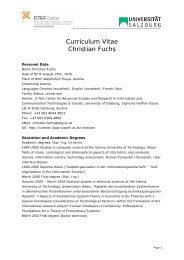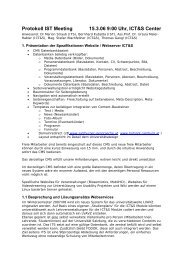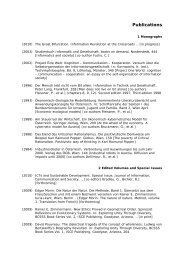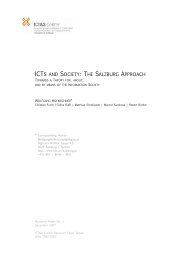CHRISTIAN FUCHS - ICT&S - Universität Salzburg
CHRISTIAN FUCHS - ICT&S - Universität Salzburg
CHRISTIAN FUCHS - ICT&S - Universität Salzburg
You also want an ePaper? Increase the reach of your titles
YUMPU automatically turns print PDFs into web optimized ePapers that Google loves.
Christian Fuchs: Social Networking Sites and the Surveillance Society(accessed on October 7, 2008).Lewis, Kevin, Jason Kaufman and Nicholas Christakis, 2008. The taste for privacy: Ananalysis of college student privacy settings in an online social network. Journal ofComputer-Mediated Communication 14 (1): 79-100.Liu, Hugo (2007) Social network profiles as taste performances. Journal of ComputerMediated Communication 13 (1).Liu, Hugo, Pattie Maes and Glorianna Davenport. 2006. Unravelling the taste fabric ofsocial networks. International Journal on Semantic Web and Information Systems 2(1): 42-71.Livingstone, Sonia. 2008. Taking risky opportunities in youthful content creation:teenagers' use of social networking sites for intimacy, privacy and self-expression.New Media & Society 10 (3): 393-411.Lyon, David. 1994. The Electronic Eye. The rise of surveillance society. Cambridge:Polity Press.Lyon, David. 2001. Surveillance society. Monitoring everyday life. Buckingham: OpenUniversity Press.Lyon, David. 2003. Surveillance after September 11. Cambridge: Polity Press.Magnuson, Melissa Joy and Lauren Dundes. 2008. Gender differences in "socialportraits" reflected in MySpace profiles. Cyberpsychology & Behavior 11 (2): 239-241.Marcuse, Herbert. 1937/1988. Philosophy and critical theory. In Negations: Essays incritical theory, 134-158. London: Free Association.Marcuse, Herbert. 1969. An essay on liberation. Boston: Beacon Press.Marwick, Alice. 2008. To catch a predator? The MySpace moral panic. First Monday 13(6).Marx, Karl. 1858/1993. Grundrisse. London: Penguin.Marx, Karl. 1867/1990. Capital Volume I. London: Penguin.Marx, Karl. 1885/1992. Capital Volume II. London: Penguin.Marx, Karl and Friedrich Engels. MEW. Werke. Berlin: Dietz.Mazer, Joseph, Richard Murphy, Richard and Cheri Simonds. 2007. I'll see you on"Facebook": The effects of computer-mediated teacher self-disclosure on studentmotivation, affective learning, and classroom climate. Communication Education 56(1): 1-17.McCaughey, Martha and Michael D. Ayers, eds. 2003. Cyberactivism. New York:Routledge.McGee, James B. and Michael Begg. 2008. What medical educators need to knowabout “Web 2.0”. Medical Teacher 30 (2): 164-169.Meadows-Klue, Danny. 2008. Falling in Love 2.0: Relationship marketing for theFacebook generation. Direct, Data and Digital Marketing Practice 9 (3): 245-250.Miller, Paul. 2005. Web 2.0: Building the New Library. In Ariadne 45:http://www.ariadne.ac.uk/issue45/miller/ (Accessed on July 9, 2007)Mitchell, Eleanor and Sarah Barbara Watstein. 2007. The places where students andscholars work, collaborate, share and plan: Endless possibilities for us! ReferenceServices Review 35 (4): 521-524.Moreno, Megan A., Norman C. Fost and Dimitri A. Christakis. 2008. Research ethics inthe MySpace era. Pediatrics 121 (1): 157-161.OECD. 2007. Participative Web and user-created content: Web 2.0, wikis and socialnetworking. SourceOECD 15 (2007): i-128.Ogura, Toshimaru. 2006. Electronic government and surveillance-oriented society. In122









